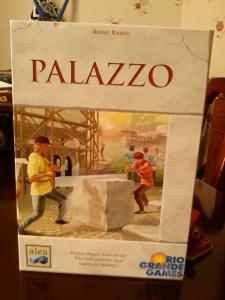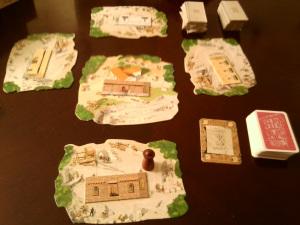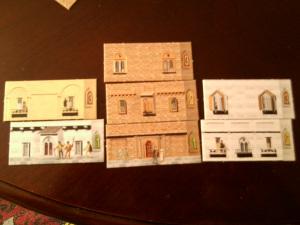
Palazzo is designed by Reiner Knizia and published by Rio Grande Games and Alea. It supports between 2-4 players and takes about 45 minutes to play.

In Palazzo you are trying to build palaces and will score points based on the height of your palace, the number of doors and windows, and the type of material the palace is made from. It is an auction game and each player will have a hand of cards. As you can see in the picture there are five boards. On a player’s turn they may collect money, which involves revealing a number of cards (this changes depending on the number of players), taking two and then the remaining players each get a card. Or, the player may wish to buy tiles or begin an auction. To do this they will pull two tiles from the relevant stack (the stacks are numbered I, II and III, so you go through the I pile first and then II and so on). The player will place one tile on the board in the centre, but with the other tile they will count the doors/windows on the tile and place it that number of boards away from the master builder (the little brown pawn). Then, the player will either buy the tiles from the center board or start an auction, and this will entail moving the master builder to the next board and those tiles will be auctioned. The player to initiate the auction will start with a certificate worth 3 and then players will bid until one wins the auction. They will place any tiles won in front of them, a typical player area may look like this:

There are a couple of rules with building, you have to build upwards (so a ’2′ cannot go on top of a ’3′ for example), but you can skip levels (so a ’3′ can go on top of a ’1′). You can spend a turn rearranging your palaces if you so wish, as the higher palaces will be worth more points. When certain tiles are pulled from the III stack the game will end and each player will work out their points, and whoever has the most wins!
Palazzo is a light auction game with a few interesting nuances. I like how when you auction it’s not for the mine the master building is on currently, so you may end up having to auction something that you don’t really want. The player interaction comes from making note of what people need and trying to outbid them or drive the price up when an auction occurs. The end of game comes creeping up quite quickly and it can lead to an rush towards the climax as people scramble for the last tiles they need to increase their score.
I also like how when a player chooses to pick up money the other players each get a card. This can actually work out to your advantage as nobody knows what you have in your hand, and if you have three cards of the same denomination but different colours they are worth 15, so you might be able to surprise the other players with a high bid.
However, there is no limit to the number of cards you can have in your hand and this leads to a situation where players hoard money and then blow it all on auctions. This is one flaw with the game because auctions only happen when players choose, and if you don’t have enough money cards then you know you are not likely to win so it can be a Mexican stand-off until one player feels confident enough to pull tiles from the stacks. Turns pass very quickly and sometimes there’s nothing you can do because you have to regain cards to your hand.
There are a number of cool decisions to make though, whether to go for the most doors/windows or to try and get your palace built with tiles made of the same material. I like how the scoring works and an interesting thing to note is that the reminder cards have two sides, one shows a visual representation of how buildings are scored and one describes it. I found the written description much more helpful than the pictures, and it’s just an interesting little note as to how people learn things in different ways.
As for the game itself, I think it’s quite cool and it’s the right length. Any longer and it would overstay it’s welcome but it ends at just the right time. It’s a light game though and it’s not one that you’d want to play over and over again because although there are a few decisions you can make they’re all along the same lines, and after a few games it can feel repetitive. The player interaction is limited but you’re still engaged on people’s turns as what they do will matter to you, unless they’re reconstructing. The components are of a good quality and the rulebook is straightforward, although I think it is wordier than it needs to be as the game is very simple.
Overall I quite like it and it’s one that I’ll be pulling out now and again but it is very structured, as you really have to hoard the money. I feel it would be better served with a hand limit so that players can’t just keep hoarding and hoarding, as the bids get to a ridiculous level sometimes. I do like the way you build palaces though, so I’d say that it’s a decent game but it’s not going to be essential to anyone’s collection.
